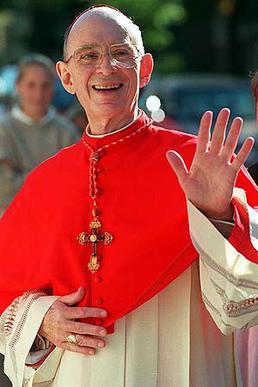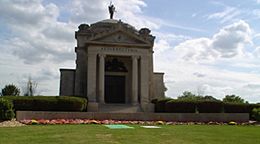Joseph Bernardin facts for kids
Quick facts for kids His Eminence Joseph Louis Bernardin |
|
|---|---|
| Cardinal, Archbishop of Chicago | |
 |
|
| See | Chicago |
| Appointed | July 8, 1982 |
| Enthroned | August 25, 1982 |
| Reign ended | November 14, 1996 |
| Predecessor | John Cody |
| Successor | Francis George |
| Other posts | Cardinal-Priest of Gesù Divin Lavoratore (Jesus the Divine Worker) |
| Orders | |
| Ordination | April 26, 1952 |
| Consecration | April 26, 1966 by Paul John Hallinan |
| Created Cardinal | February 2, 1983 |
| Rank | Cardinal-Priest |
| Personal details | |
| Born | April 2, 1928 Columbia, South Carolina |
| Died | November 14, 1996 (aged 68) Chicago, Illinois |
| Previous post |
|
| Motto | As Those Who Serve |
| Coat of arms |  |
| Styles of Joseph Bernardin |
|
|---|---|
 |
|
| Reference style | His Eminence |
| Spoken style | Your Eminence |
| Informal style | Cardinal |
| See | Chicago |
Joseph Louis Bernardin (born April 2, 1928 – died November 14, 1996) was an important American Cardinal in the Catholic Church. He served as the Archbishop of Cincinnati from 1972 to 1982. Later, he became the Archbishop of Chicago in 1982 and served there until he passed away in 1996. He was made a cardinal in 1983 by Pope John Paul II.
Contents
Early Life and Education
Joseph Bernardin was born on April 2, 1928, in Columbia, South Carolina. His parents, Joseph Bernardin and Maria Maddalena Simion, were immigrants from a village in what is now northern Italy. He was baptized and confirmed at St. Peter's Catholic Church in Columbia.
When Joseph was six years old, his father died from cancer. Joseph took on the responsibility of caring for his younger sister, Elaine. His mother worked as a seamstress to support the family.
Joseph first wanted to become a doctor. He started studying medicine at the University of South Carolina. However, he later decided to study for the priesthood. He transferred to Saint Mary Seminary in Baltimore, Maryland. In 1948, he earned a degree in Philosophy. After that, he went to The Catholic University of America to finish his studies in theology.
Becoming a Priest and Bishop
On April 26, 1952, Joseph Bernardin became a priest for the Diocese of Charleston. This diocese covers the whole state of South Carolina. He was ordained by John J. Russell at St. Joseph Church.
For 14 years, Father Bernardin worked in the Diocese of Charleston. He served under four different bishops. He held important roles like chancellor and vicar general. In 1959, Pope John XXIII gave him the special title of Monsignor.
Auxiliary Bishop of Atlanta
On March 9, 1966, Pope Paul VI chose Bernardin to be an Auxiliary Bishop for the Archdiocese of Atlanta. An auxiliary bishop helps the main bishop of a large area. His special ceremony to become a bishop happened on April 26, 1966. He was only 38 years old, making him the youngest bishop in America at that time.
From 1966 to 1968, Bishop Bernardin was also the rector (head priest) of the Cathedral of Christ the King in Atlanta, Georgia. It was in the southern United States, where many people are not Catholic, that Bernardin learned about ecumenism. This means working to bring different Christian churches closer together.
Leading the National Conference
In 1968, Bernardin became the first General Secretary of the National Conference of Catholic Bishops. This group helps guide the Catholic Church in the United States. He held this important job until 1972. In 1969, he helped start the Catholic Campaign for Human Development (CCHD). This program helps fight poverty.
Archbishop of Cincinnati
Pope Paul VI appointed Bernardin as the Archbishop of Cincinnati on November 21, 1972. He officially started his new role on December 19, 1972. He served as Archbishop of Cincinnati for almost ten years. During this time, he appointed the first woman editor of the archdiocese's newspaper, The Catholic Telegraph.
While in Cincinnati, Bernardin was chosen for important roles in the worldwide Catholic Church. He also worked to improve relationships between Catholics and Jews, and between the Catholic Church and Protestant churches. He visited Poland and Hungary to meet with Catholics there.
Archbishop of Chicago
After the death of Cardinal John Cody in Chicago, Pope John Paul II chose Archbishop Bernardin to lead the Archdiocese of Chicago. He was appointed the twelfth Bishop and seventh Archbishop of Chicago on July 10, 1982. He was officially installed on August 25, 1982.
When Bernardin arrived, the archdiocese was facing challenges. Priests felt discouraged, and there were concerns about how money was managed. Cardinal Bernardin used his calm and patient way of listening to help bring back trust among the clergy (priests) and the people.
Becoming a Cardinal
On February 2, 1983, Pope John Paul II made him a Cardinal-Priest. This is a very high rank in the Catholic Church. His special church in Rome was called Gesù Divino Lavoratore (which means "Jesus the Divine Worker").
Awards and Honors
Cardinal Bernardin received many awards for his service.
- In 1989, he received the F. Sadlier Dinger Award for his work in religious education.
- In 1983, he gave speeches and received honorary degrees from the College of the Holy Cross and Notre Dame.
- In 1995, he received the Laetare Medal from the University of Notre Dame. This is their highest honor for service to the Catholic Church and society.
- In 1990, he received the Golden Plate Award from the American Academy of Achievement.
- After he passed away, in 1997, he was given the Order of Lincoln. This is the highest honor from the State of Illinois.
- He was also awarded the Presidential Medal of Freedom by President Bill Clinton. This is one of the highest civilian awards in the United States.
Final Illness and Passing
In June 1995, after many trips, Cardinal Bernardin had surgery for pancreatic cancer. On August 30, 1996, he announced that the cancer had returned and spread to his liver. It could not be operated on. He handed over the daily running of the Archdiocese to his auxiliary bishop, Raymond Goedert.
Bernardin then focused his ministry on helping others who were sick. He became like an "unofficial chaplain" for cancer patients in Chicago.
On September 23, he traveled to Rome to visit Pope John Paul II and Assisi. During this trip, he made plans for his funeral. When he returned to Chicago, he arranged care for his mother, whom he visited every day. He also organized his personal belongings.
Two weeks before he died, he finished a book about the end of life and his own approaching death. It was called The Gift Of Peace.
He said goodbye to 800 priests from the Archdiocese at Holy Name Cathedral. By the end of October, he stopped his active work because he was getting weaker.
On November 14, 1996, Cardinal Bernardin passed away from pancreatic cancer at the age of 68.
His friend, Monsignor Kenneth Velo, gave the speech at his funeral. In his last weeks, Bernardin often said he was at peace because of his strong faith in God. He saw death as a "continuation" and a "friend" to prepare for. He was buried in the Bishops' Mausoleum at Mount Carmel Cemetery (Hillside, Illinois).
Cardinal Bernardin's Views
Social Issues
In 1981, Cardinal Bernardin led a committee to write a letter about nuclear weapons. This letter, called "The Challenge of Peace: God's Promise and Our Response", was published in 1983. It was an important statement from the Catholic Church. It said that nuclear war was wrong. It also said that having nuclear weapons to prevent war (called nuclear deterrence) was only a temporary solution. It should only be used while working towards arms control and disarmament. Because of his work on this topic, Bernardin was featured on the cover of Time Magazine in 1982.
Bernardin also worked to bring different groups within the Catholic Church closer together. In 1996, he started the Catholic Common Ground Initiative. This group aimed to find common ground among Catholics with different ideas.
He cared a lot about young adults. He supported the "Theology on Tap" movement, which offered talks about faith in a relaxed setting. In 1985, he told young people, "If I had children of my own, they would be your age. You are very special to me and to this Archdiocese."
Cardinal Bernardin also helped people affected by the AIDS crisis. In 1985, he created a special group to figure out how the Archdiocese could best care for them. In 1989, he helped open Bonaventure House, a home for people living with AIDS.
Interfaith Relations
Bernardin strongly believed in ecumenism, which means working with other religions. While he was Archbishop of Cincinnati, he talked with Jews, Presbyterians, Episcopalians, and Lutherans.
In 1984, he started the Council of Religious Leaders of Metropolitan Chicago. He was the first president of this group. Under Bernardin, the Archdiocese of Chicago made special agreements with the Episcopal Diocese of Chicago and the Evangelical Lutheran Church.
Bernardin attended the World Parliament of Religions in Chicago in 1993. In 1995, he led a trip to the Holy Land (Israel and Palestine) to meet with leaders and promote peace. He spoke out against violence in places like Lebanon, Israel, and Northern Ireland. He wanted the Catholic Church to be a "peace church."
Legacy and Impact
Cardinal Bernardin was a very important person in the Catholic Church in the United States after the Second Vatican Council. Some people called him one of the most powerful Catholic leaders in American history.
Two Catholic schools in Chicago are named after him: the Cardinal Joseph Bernardin School and the Cardinal Bernardin Early Childhood Center.
The Cancer Treatment Center at Loyola University of Chicago is called the "Cardinal Bernardin Cancer Center."
In his hometown of Columbia, South Carolina, his baptism church, St. Peter's, named the Cardinal Bernardin Center after him. The University of South Carolina also started an annual lecture series in his honor in 1999. A street in Chicago, Cardinal Bernardin Way, is named after him. The Bernardin Center for Theology and Ministry at Catholic Theological Union (CTU) in Chicago hosts his Catholic Common Ground Initiative.
The CCHD also gives out the Cardinal Joseph Bernardin New Leadership Award each year to young achievers.
Criticism
Some people, like author George Weigel, have criticized Cardinal Bernardin's influence. Weigel suggested that Bernardin created a system to appoint bishops who then led the American Catholic Church for many years. He also said Bernardin promoted a type of Catholicism that was too open to modern culture. Weigel saw the election of Archbishop Timothy Dolan over Bishop Gerald Kicanas in 2010 as the end of the "Bernardin era."
See also
- Catholic Church in the United States
- Historical list of the Catholic bishops of the United States
- Italians in Chicago
- List of Catholic bishops of the United States
- Lists of patriarchs, archbishops, and bishops
Sources
- Millies, Steven P. Joseph Bernardin: Seeking Common Ground, Liturgical Press, 2016. ISBN: 978-0-8146-4831-5.
- Bernardin, Joseph. The Gift of Peace: Personal Reflection, Doubleday, 1998. ISBN: 978-0-385-49434-2.
- Wall, A.E.P. The Spirit of Cardinal Bernardin, Thomas More Press, 1983. ISBN: 0-88347-156-6. Thomas More Press, 1997. ISBN: 0-88347-379-8.
| Catholic Church titles | ||
|---|---|---|
| Preceded by John Krol |
President of the United States Catholic Conference and National Conference of Catholic Bishops 1974–1977 |
Succeeded by John R. Quinn |
| Preceded by Paul Francis Leibold |
Archbishop of Cincinnati 1972–1982 |
Succeeded by Daniel Edward Pilarczyk |
| Preceded by John Cody |
Archbishop of Chicago 1982–1996 |
Succeeded by Francis George |


